This quick and easy recipe takes your classic Nian Gao (Chinese New Year rice cake) to another level by adding additional ingredients for extra flavour. It tastes great either as it is or pan-fried.
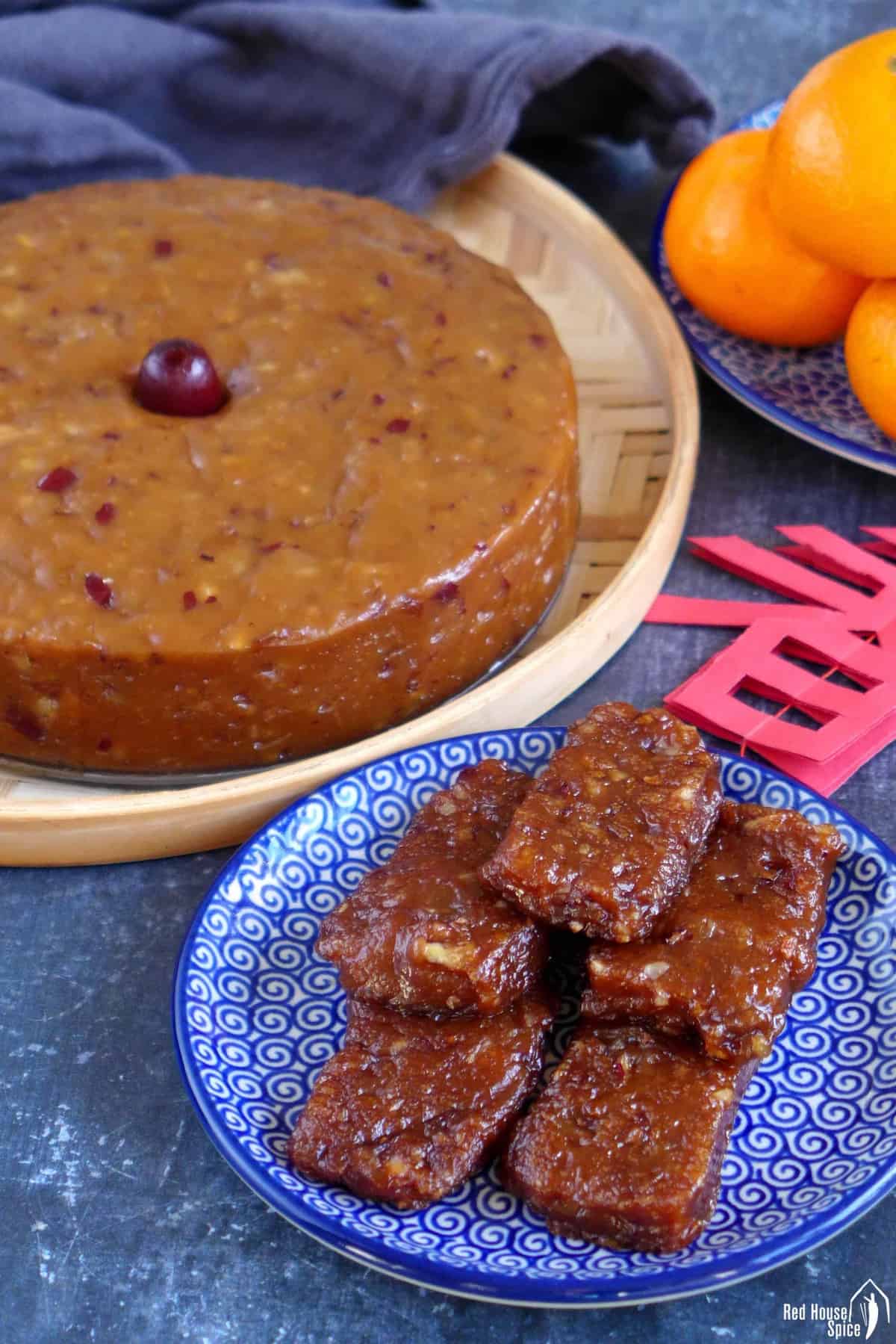
Jump to:
What is Nian Gao?
Nian Gao (年糕), also called “Nin Go” in Cantonese, is known worldwide as Chinese New Year Rice Cake. Traditionally, it comprises key ingredients like glutinous rice flour, regular rice flour, and brown sugar. They are mixed together and steamed to form a round, sticky and gooey cake with a caramel-like sweetness.
The term Nian/年 literally translates as “year” while Gao/糕 refers to “cake” which shares the same pronunciation with the character 高 which means “tall” or “high.” So this sweet treat is a must-have Chinese New Year delicacy for many families as eating it on this special occasion symbolises prosperity and a better year ahead.
Nowadays, Nian Gao comes in different varieties depending on the region or family preference. Some variations involve red bean paste, taro, purple yam, dates, and nuts. However, regardless of where they are made and how they are flavoured, the key ingredients remain the same.
🌟 NOTE: I also have a savory rice cake recipe that might interest you: Stir-Fried Rice Cake.
Why this recipe
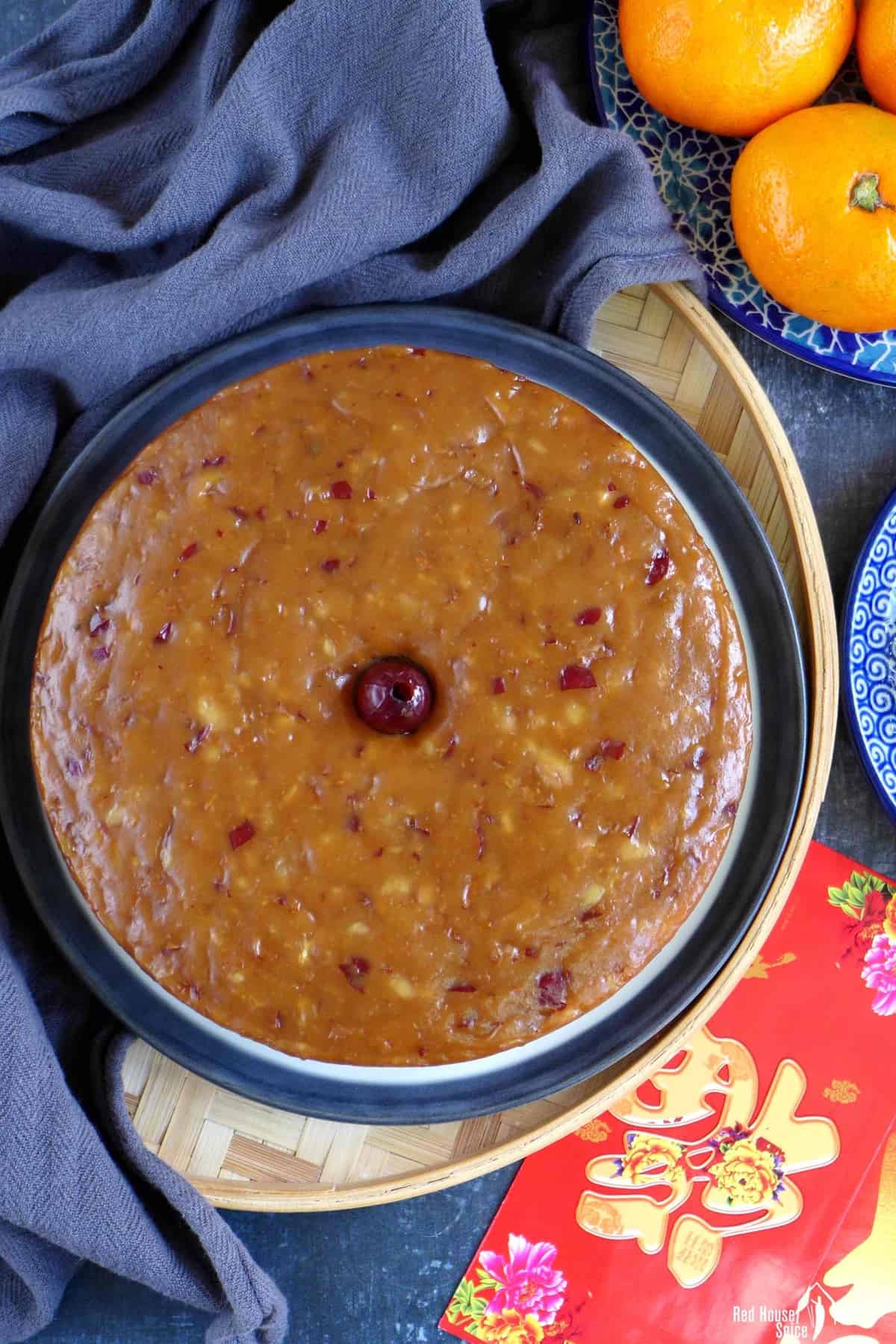
I’ve had my share of New Year rice cake, but the version I’m sharing today is one of the best I have ever tasted. Aside from the base ingredients, it includes finely chopped Chinese dates (aka Jujube or red dates) and walnuts. The dates add a sweet flavour with a hint of tart, while the walnuts add pops of nuttiness and crunch in each bite.
Another thing I like about this recipe is that it doesn’t require lengthy steaming time (some other methods need 1-2 hours). This is because it involves using hot sugar liquid to partially cook the flour mixture and form a soft dough. It veers away from the traditional way of making a runny batter.
Ingredients
Here is what you need for this recipe:
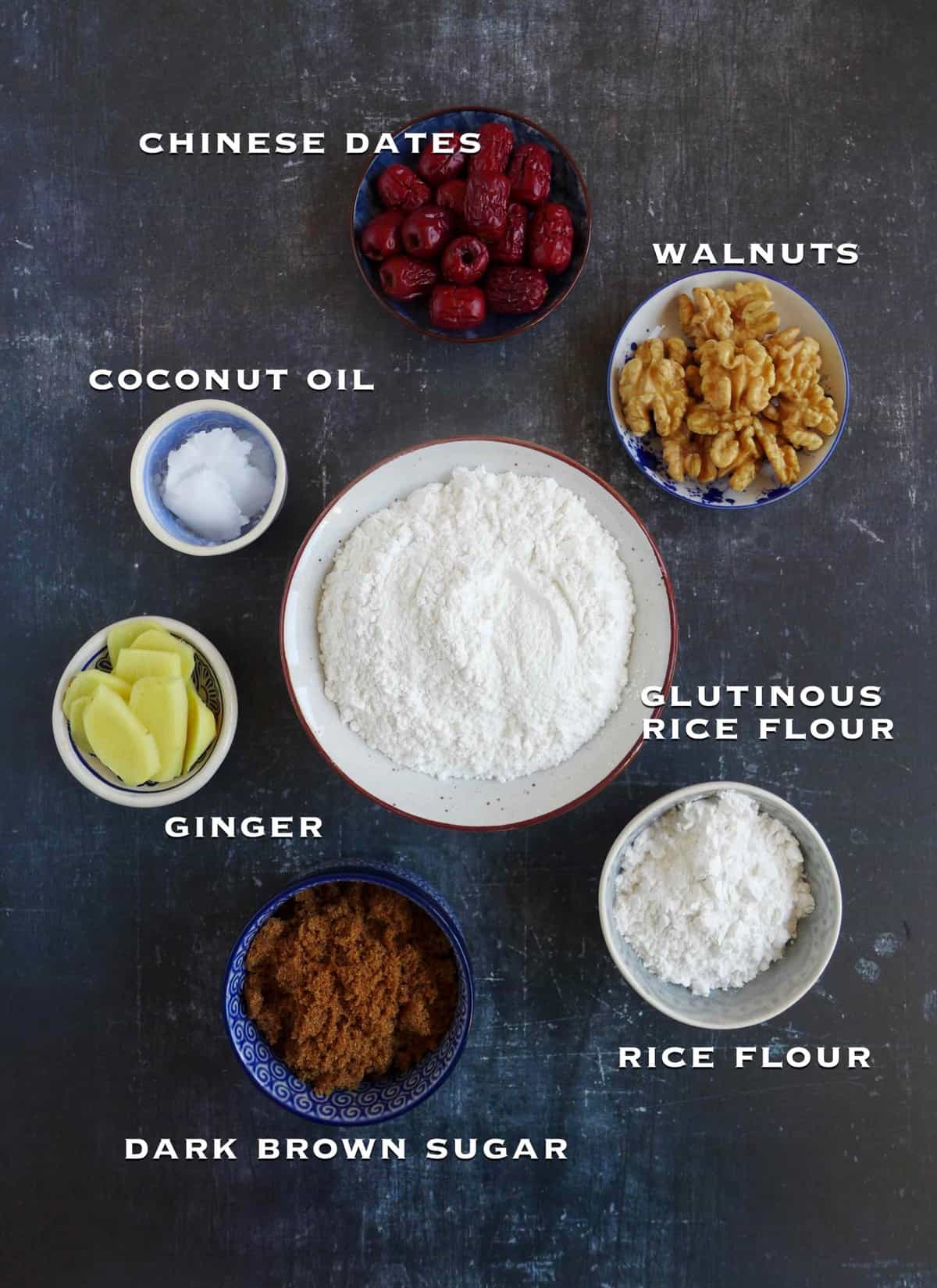
- Glutinous rice flour (Nuo Mi Fen/糯米粉). The most important ingredient of Nian Gao, it’s made of finely ground glutinous rice (aka sweet white rice). It’s characterised by its sticky, stretchy nature once cooked, thus the name. This type of flour is actually gluten-free, despite its confusing name.
- Regular rice flour (Nian Mi Fen/粘米粉). It‘s made of milled regular rice, the type we usually steam and eat with savoury dishes.
- Dark brown sugar. You can also use muscovado sugar or Chinese brown rock sugar known as Bing Pian Tang (冰片糖).
- Chinese dates. They are the fruits of the Jujube shrub, also known as red dates or Chinese jujube. This recipe calls for dried ones which can be found in Chinese stores. They have a sweet, slightly tart taste and chewy texture.
- Walnuts. You can also use peanuts or other nuts of your choice.
- Ginger. It gives a zesty and peppery undertone to the Nian Gao.
- Oil. I like coconut oil as its subtle aroma pairs very well with other ingredients in this recipe. If unavailable, replace it with other neutral-tasting cooking oil.
🛎 TIP: The recommended ratio of glutinous rice flour and regular rice flour is about 5 to 1. Please feel free to increase the latter if you prefer your Nian Gao with a firmer, less sticky texture.
Equipment required
- A heatproof container. I use a springform cake tin to make Nian Gao. You can also use other types of cake tins, baking trays, food storage containers, or deep plates. Although the traditional version is round-shaped, a square container works too.
- A steamer. If unavailable, you can improvise and make your own steaming setup using a wok/pot and a small bowl. Check out my post on Pumpkin Mochi Cake to learn how it works.
Cooking procedure
Prepare dried ingredients
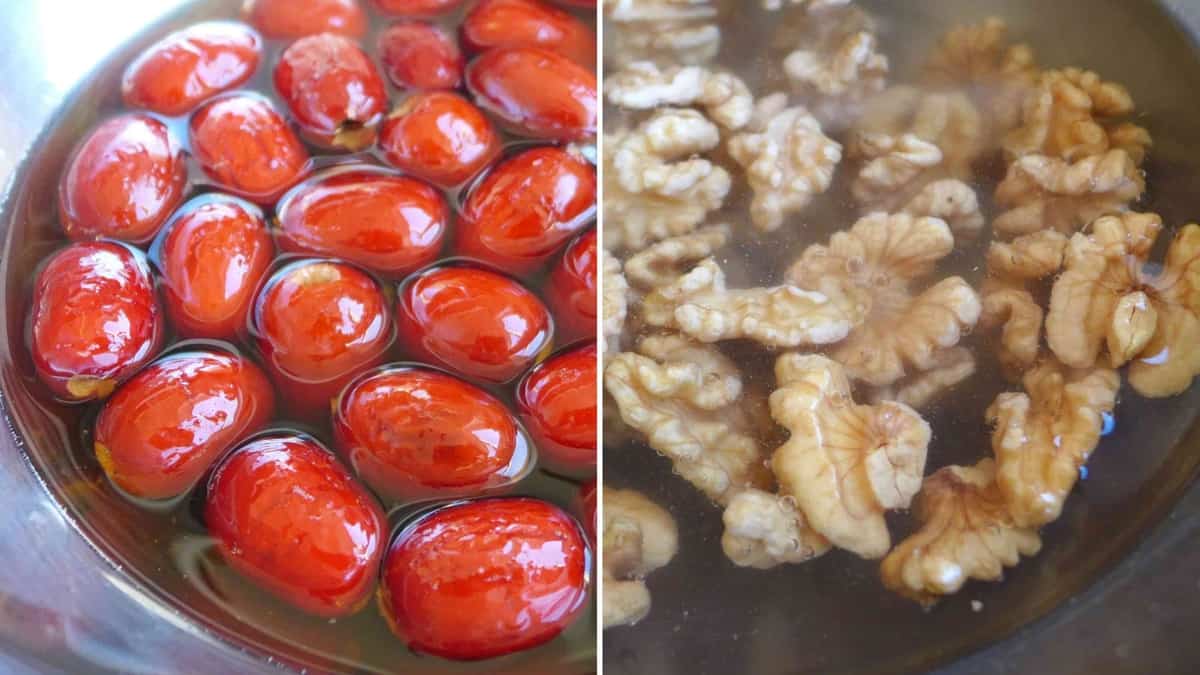
Soak Chinese dates and walnuts until they’re well rehydrated. This makes chopping much easier. Also, they tend to release more aroma during cooking.
Brush a thin layer of oil over the inner surface of the cake tin (or the container of your choice), and line the bottom with parchment paper.
Cooking steps
Drain the Chinese dates and walnuts and remove the pits of the dates if any (Remember to keep one whole date for garnishing later). Finely chop them by hand or using a food processor.
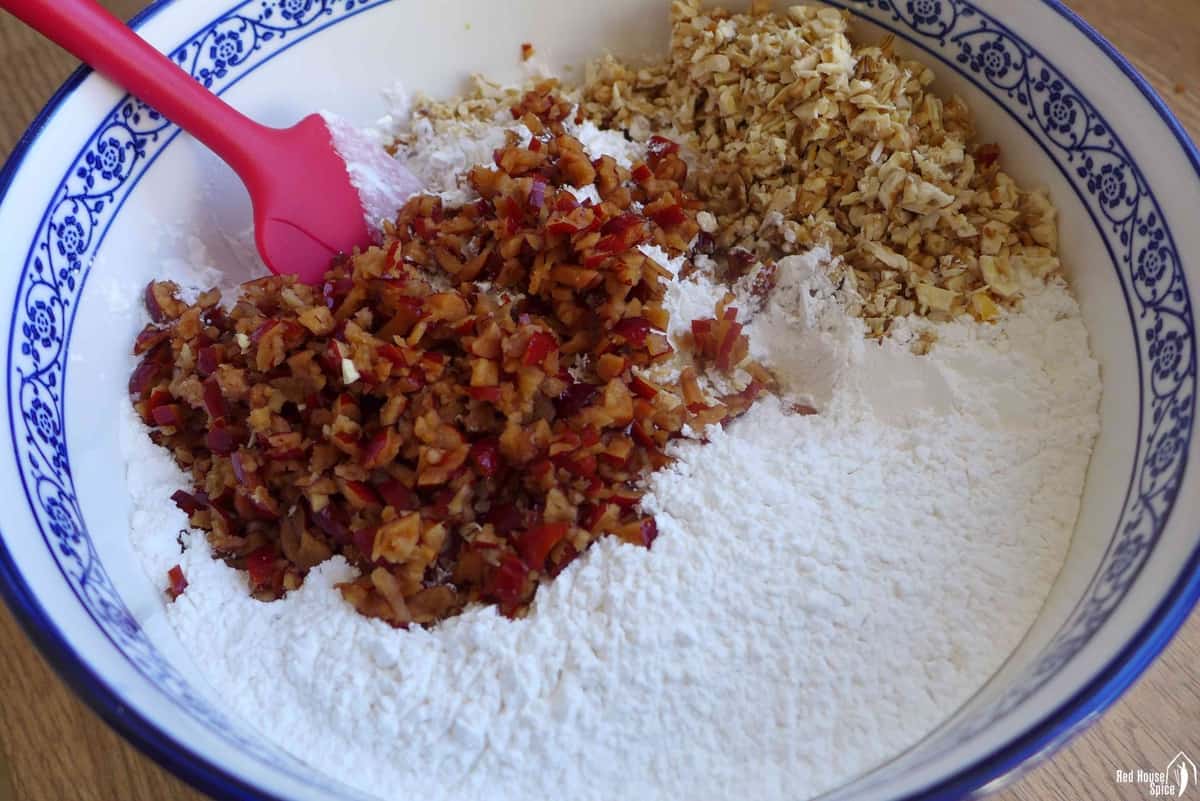
Add glutinous rice flour and regular rice flour into a large mixing bowl. Put in the chopped dates and nuts. Mix until everything is well incorporated.

In a saucepan, add dark brown sugar, ginger, and water and bring to a boil. Reduce heat to low, and let the mixture simmer with the lid on for three minutes or so. Remove the ginger, then stir in the oil. Whisk until fully incorporated.
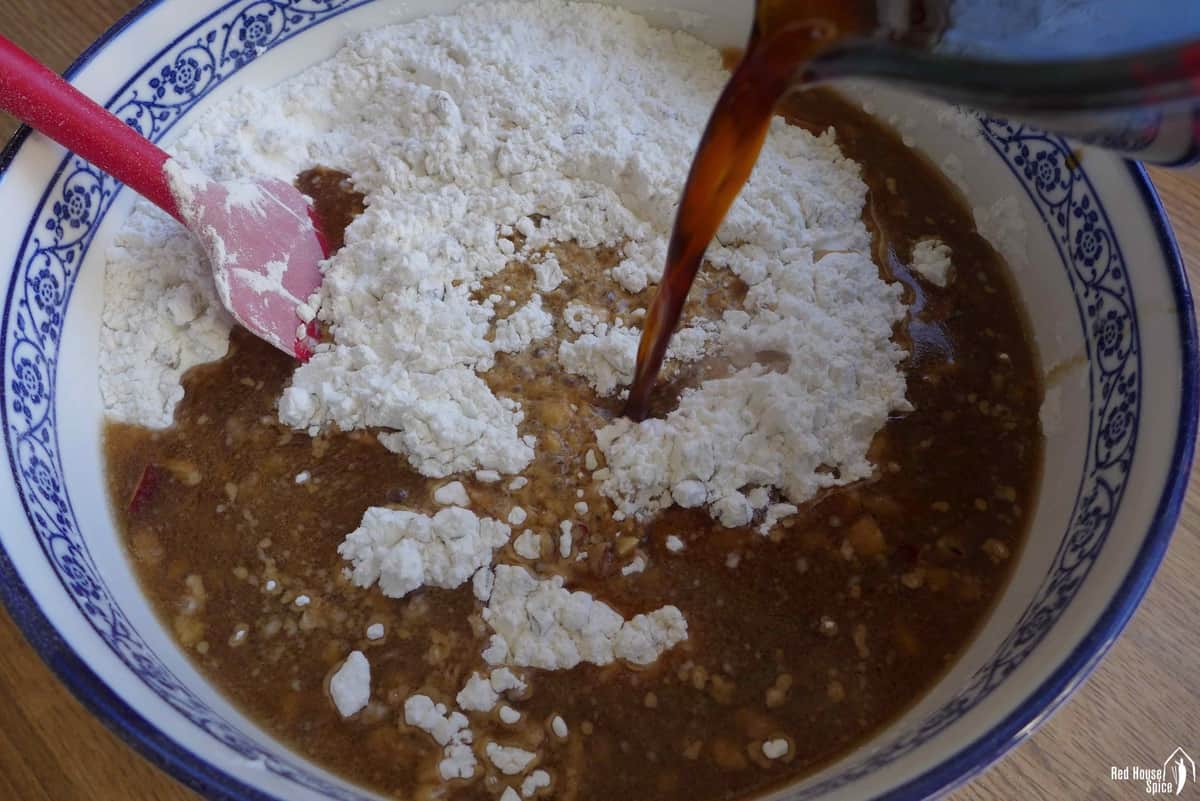
Pour about 90% of the hot sugar liquid over the flour mixture. Mix and lightly knead. Add the remaining liquid gradually until a soft dough forms. Depending on the evaporation loss while simmering, you may not use all the liquid, or you might need to add a little extra water. Please feel free to adjust.
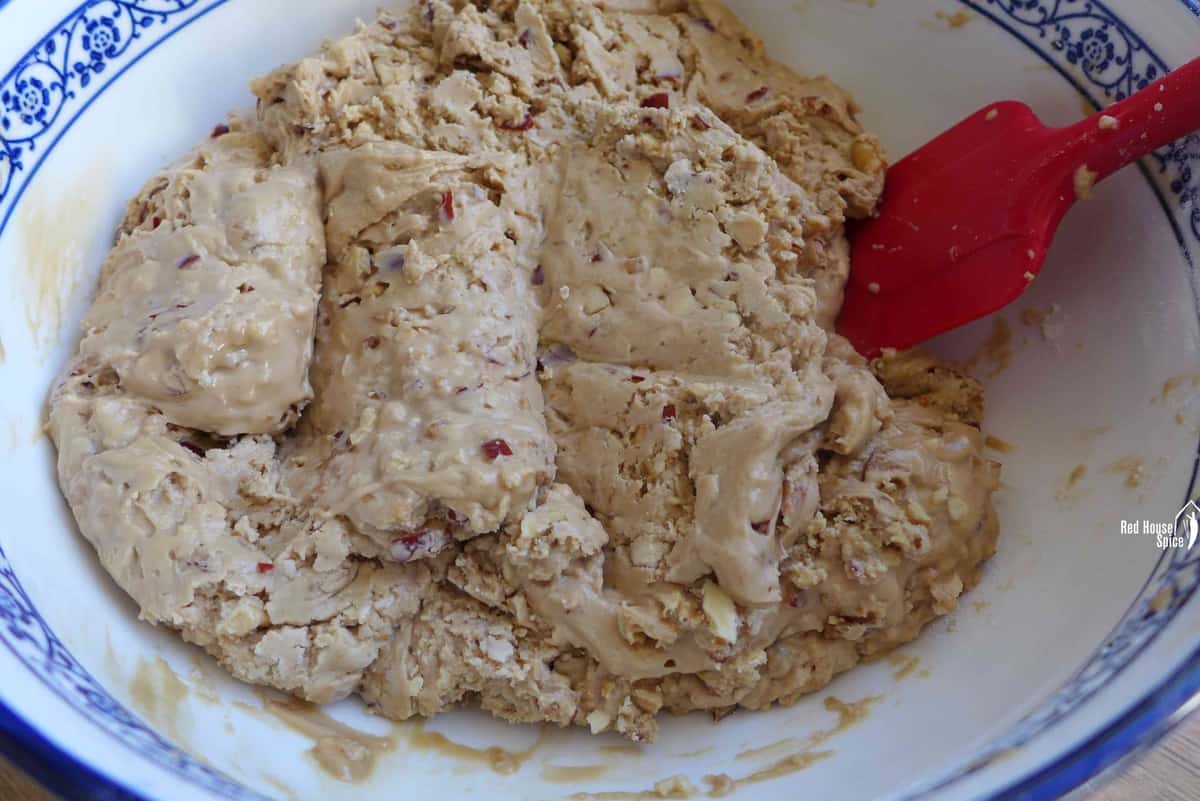
Transfer the dough into your prepared cake tin/container. Use a spatula to flatten the surface and insert a whole date into the centre of the cake.
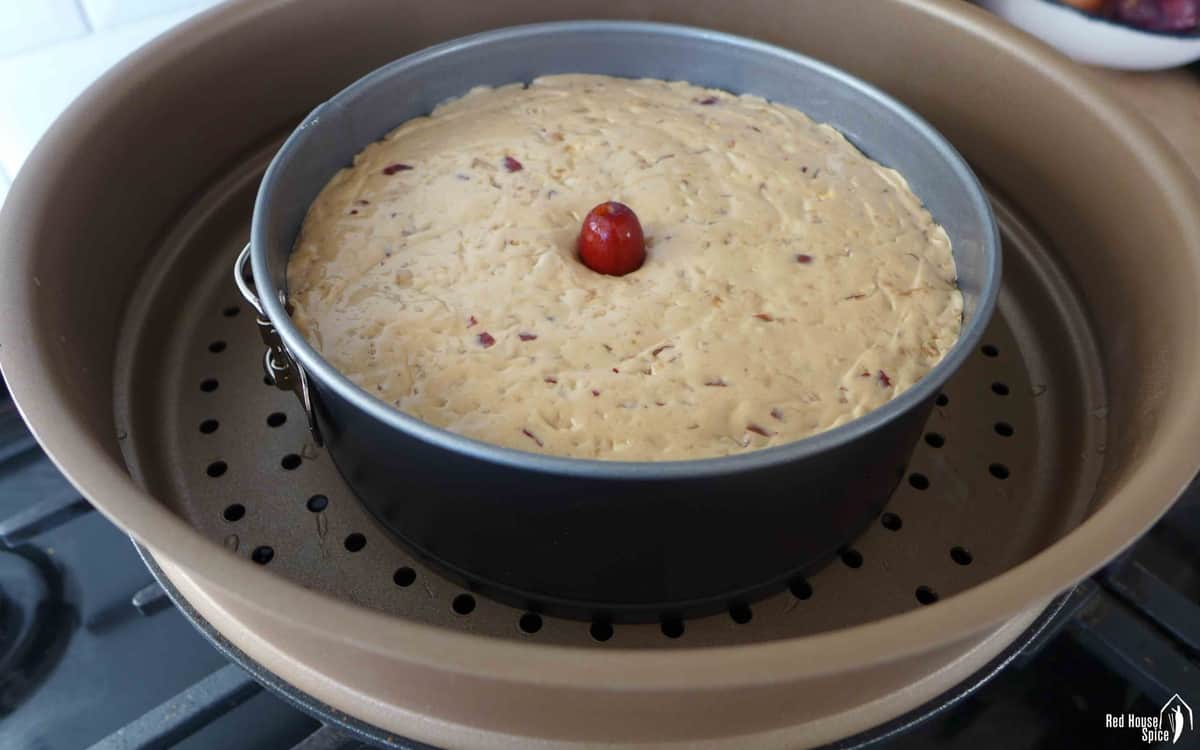
Place the cake tin/container into the steamer basket. Then, place the steamer basket on top of the wok/pot filled with boiling water. Cover with the lid and steam for 45 minutes over medium heat.
🛎TIPS:
- Remember to check the water level halfway through steaming and top up if necessary.
- Do not oversteam your Nian Gao, or it will become dry and tough to chew. The best way to check the doneness is to poke a toothpick or chopstick through the centre of the cake. If it comes out clean, the cake is fully cooked.
How to serve
You can enjoy Chinese New Year rice cake in two ways:
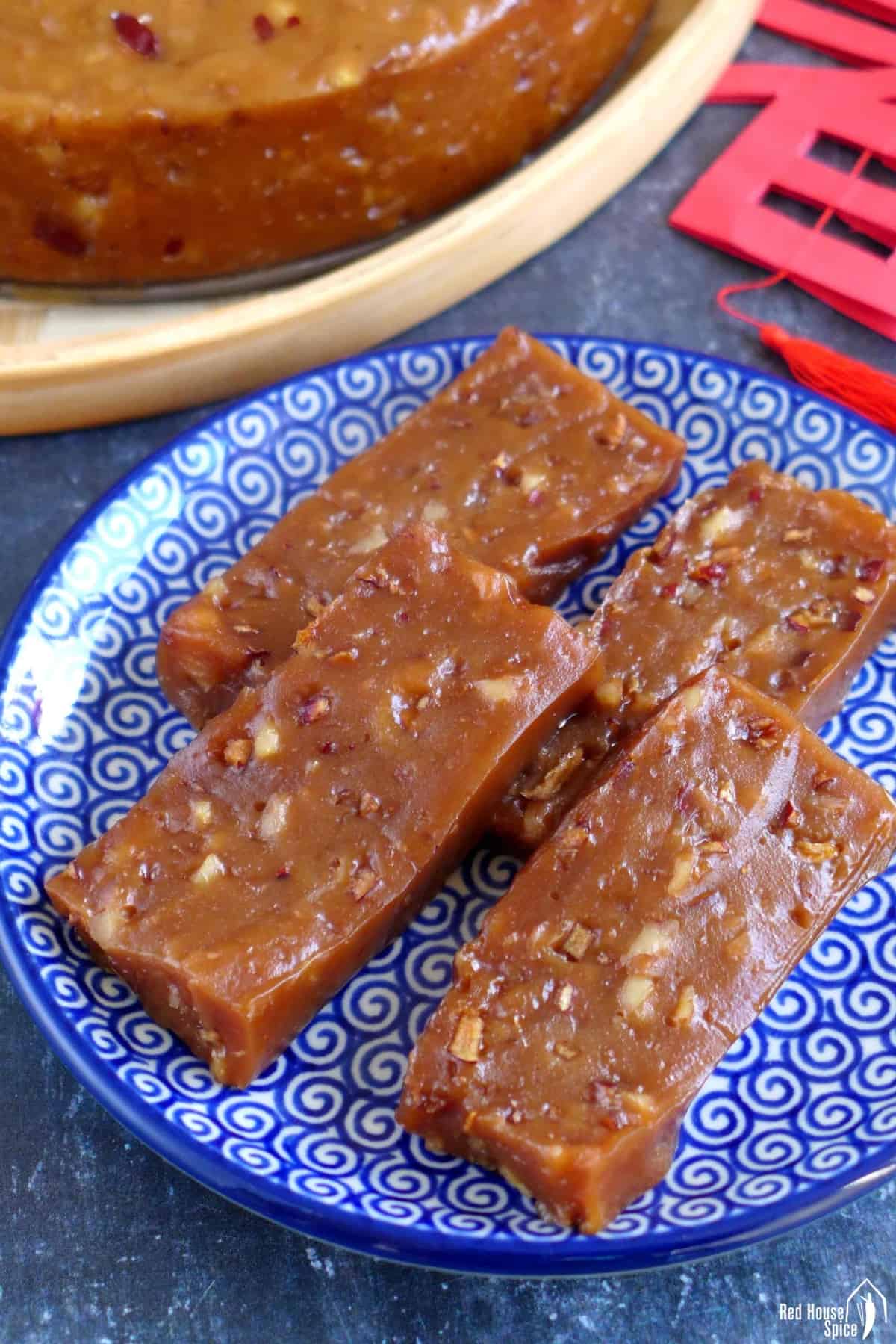
- Slice and eat it at room temperature. Slightly grease your knife before cutting to avoid sticking. Refrigeration also makes slicing easier as the cake will become firmer.
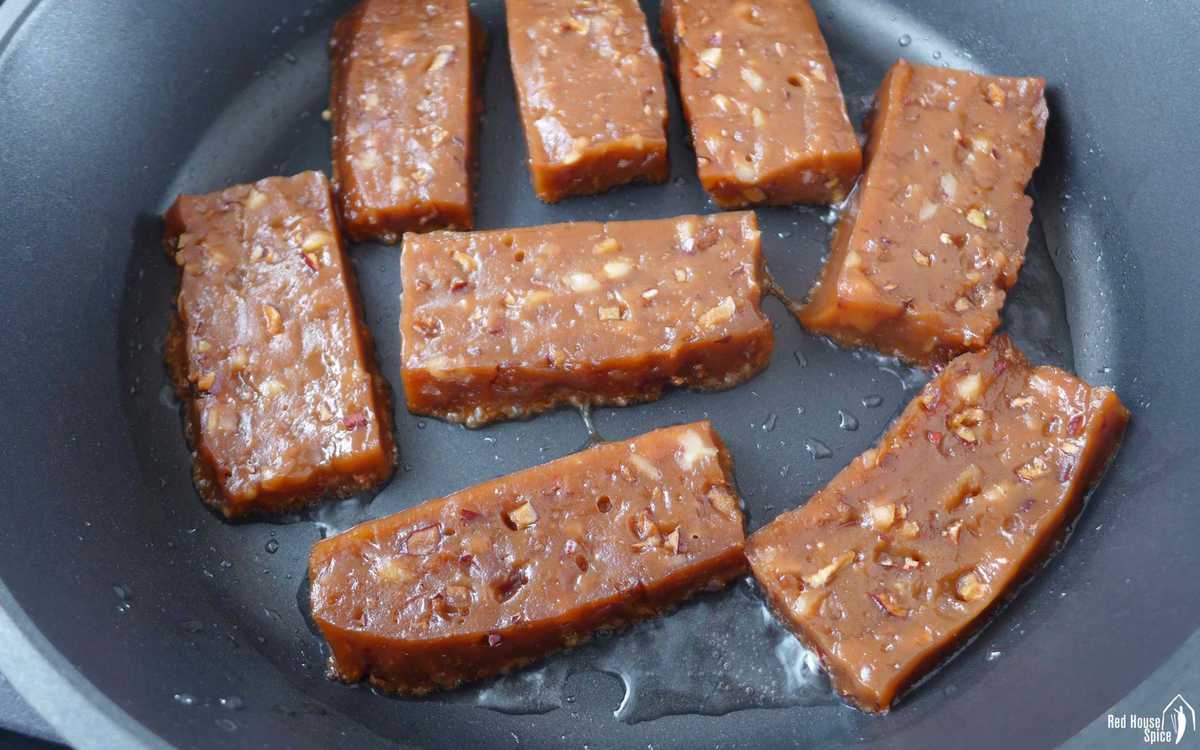
- Pan-fry sliced Nian Gao. You may fry it with just a little oil until it softens and the surface forms blisters. Alternatively, coat each slice with a layer of beaten egg then pan fry with oil. This creates an extra crispy crust.
Storage suggestions
When preparing for Chinese New Year, I always make Nian Gao ahead of time. You can leave it on the counter for 1 day, or keep it in the fridge for up to 5 days. Remember to put it in an air-tight bag/container to avoid drying out.
Nian Gao freezes very well too. Cut it into pieces before freezing. Defrost in the fridge then enjoy it at room temperature, or pan-fry it without defrosting.
I also recommend you make several cakes at once and give them to family and friends as gifts. Nian Gao makes a wonderful present at this important festival. It’s a great way to wish prosperity to your loved ones.
Other Chinese treats
Looking for more classic Chinese treats? Here are a few examples:
📋 Recipe
Love this recipe? Please leave a 5-star 🌟🌟🌟🌟🌟 rating in the recipe card below & if you REALLY like it, consider leaving a comment as well!
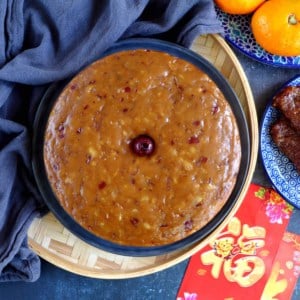
Nian Gao (Chinese New Year Rice Cake, 年糕)
BEFORE YOU START
EQUIPMENT
- 1 cake tin (20 cm / 8 in) or other heatproof container of similar size
Ingredients
- 100 g dried Chinese dates (aka jujube)
- 100 g walnuts (or peanuts)
- 450 g glutinous rice flour
- 100 g regular rice flour
- 180 g dark brown sugar (or muscovado sugar, brown rock sugar)
- 1 thumb-sized ginger, sliced
- 470 g water
- 45 g coconut oil (or neutral cooking oil) - plus a little for coating
Instructions
Prepare the dates and nuts
- Soak Chinese dates and walnuts in water overnight. Chop the rehydrated dates (pits removed if any) and walnuts into small pieces by hand or using a food processor (remember to keep one whole date for garnishing later).
- Transfer the chopped dates and walnuts to a large mixing bowl. Add glutinous rice flour and regular rice flour. Mix well.
Cook the syrup
- Add dark brown sugar, ginger and water to a saucepan. Bring to a boil then leave to simmer (cover with a lid) over low heat for 3 minutes. Remove the ginger from the sugary water then add the oil. Whisk to fully incorporate.
Make the dough
- Pour about 90% of the hot sugar liquid over the flour mixture. Mix and lightly knead. Add the remaining liquid gradually until a soft dough forms. Depending on the evaporation loss while simmering, you may not use all the liquid, or you might need to add a little extra water. Adjust accordingly.
Steamed the cake
- Brush a thin layer of oil over the inner surface of a 20 cm (8 in) cake tin. Place a piece of baking paper at the bottom. Transfer the dough into the tin. Flatten the surface. Insert the remaining date in the middle of the cake.
- Bring water to a full boil in the wok/pot which you use for steaming. Place the cake tin into the steaming basket or over a steaming rack. Cover with a lid and leave to cook over medium heat for 45 minutes (check the water level halfway through and top up if necessary).
Serve the cake
- Let the cake cool naturally in the tin. Then gently take it out. You may slice it and eat it straight away. Or, store it in the fridge, then slice and pan fry in a little oil until both sides blister.
Store the cake
- Put the cake in an air-tight bag/container once completely cooled. You can leave it on the counter for 1 day (unless the room is very warm), or keep it in the fridge for up to 5 days.
- It freezes well too. Slice it into pieces before freezing. Defrost in the fridge then enjoy it at room temperature, or pan-fry it without defrosting.
NUTRITION DISCLOSURE: Nutritional information on this website is provided as a courtesy to readers. It should be considered estimates. Please use your own brand nutritional values or your preferred nutrition calculator to double check against our estimates.


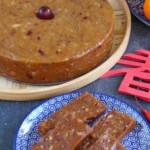
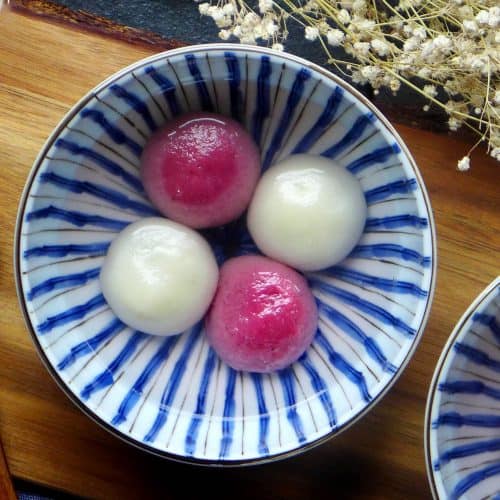
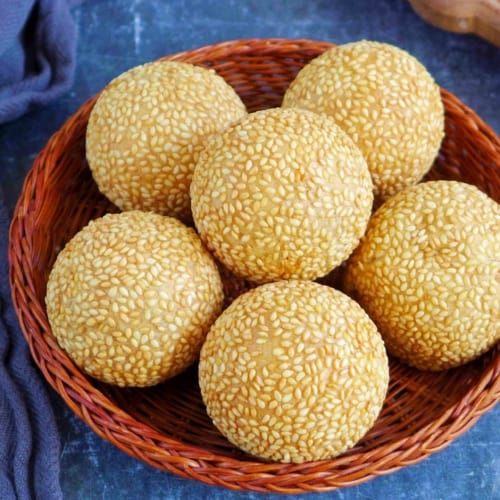
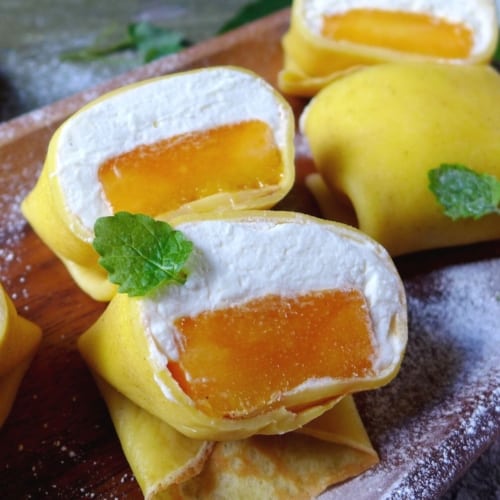
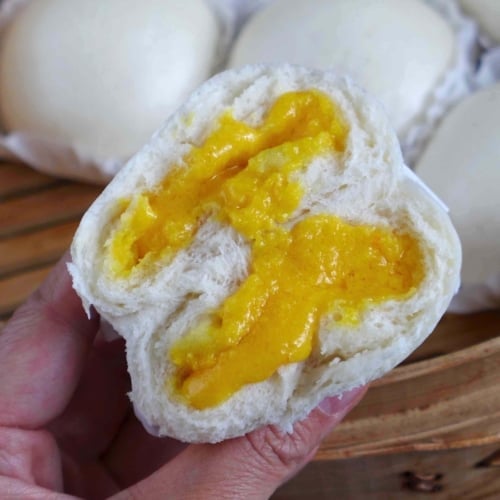
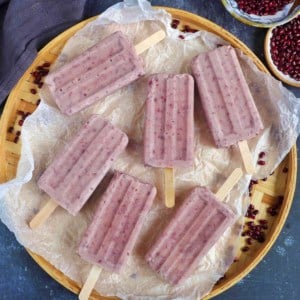
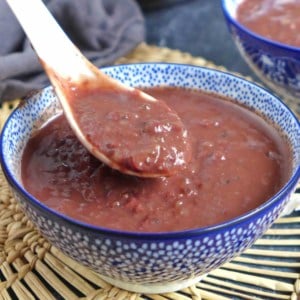
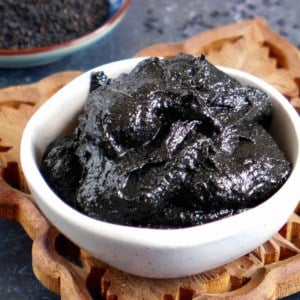
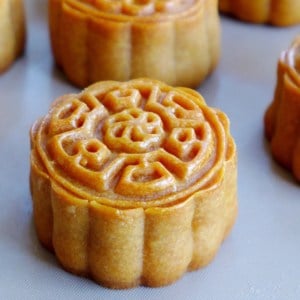
Hello, are we allowed to use light brown sugar instead of dark brown sugar? What is the importance of dark instead of light brown sugar?
You could use light brown sugar to substitute. I find that dark brown sugar has a very nice aroma besides the sweetness. Also it adds a little color to the dish
Very interested in trying this recipe. I am intrigued in adding ginger into the sugar water as well as steaming it as a dough. I like my nian gao plain. If I omit the dates and nuts does everything else remain the same?
Yes it would work without dates and walnuts. The flour and liquid ratio might be a little different. Adjust if necessary.
Hi there! May I know if I can use roasted walnuts – if so is the soaking step still required? Also, is there a need to cover the nian gao during steaming? Thanks!!
Yes, you can use roasted walnuts and I still recommend soaking. Through my trails, I’ve found that it doesn’t make too much of a difference whether covering the cake or not. If you see a little water on top of the cake after cooking, simply wipe it off with kitchen paper. That said, please feel free to cover it with cling film if you wish.